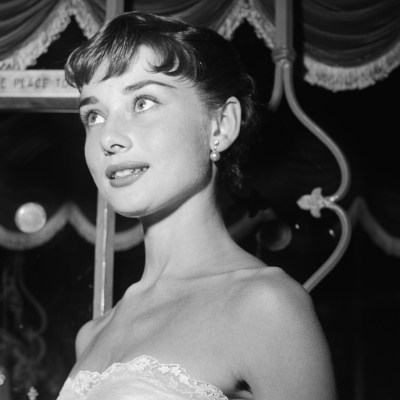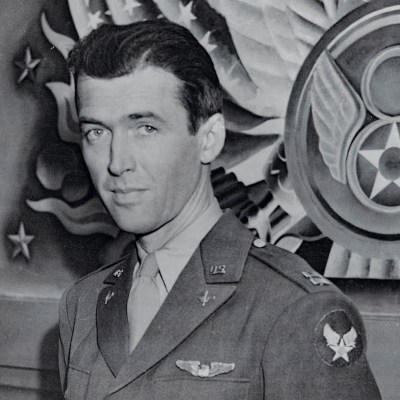Clark Gable and His WW2 Death Wish
When Clark Gable flew into World War II combat, he was 42, the King of Hollywood, and, according to his superiors, hoping to die in a plane crash.

Clark Gable did not intend to see action when World War II came to America. Which is not to say he ignored the war. Gable was there that day in 1940 when President Franklin Roosevelt gave his famous “Arsenal of Democracy” speech from the Oval Office. And, indeed, the first thing the movie star did when he heard about the Pearl Harbor attack was cable FDR to offer his full support—and, tellingly, the besieged president promptly answered right back.
But then in the 1930s and early ‘40s, Gable was “the King of Hollywood;” the reigning movie star who could sell more tickets than anybody this side of Shirley Temple, and he didn’t have to sing or dance to do it either. He was a mustachioed and muscular alpha who appealed to everybody, even presidents, and was one of the few leading men who would tell Louis B. Mayer no (at least until casting for Gone with the Wind came along). The government saw the value in that kind of celebrity when the dark storm clouds of war gathered over Europe and the South Pacific, and so did Gable. Still, he was practically 41 when the bombs fell in Hawaii and more than happy to support the war from afar.
As he told fellow MGM stablemate Jimmy Stewart at the latter’s going away party in 1940—Stewart had just happily joined the Army—“You know you’re throwing away your career, don’t you?” When Stewart answered yes, Gable added, “You won’t catch me doing that, but I wish you godspeed.”
Gable had success, Gable had power, and for the first time in his four decades on this earth, Gable had something approaching peace thanks to his marriage to Carole Lombard, the firecracker screwball star. Yet in less than a year, all of those things turned to ash following Lombard’s violent death. When her plane went down in a fiery blaze, it was treated as a national tragedy around the country, and for her husband it was the beginning of the end.
The King became broken, despondent, and finally disillusioned enough to enlist in the U.S. Army Air Corps. To this day, some say he went to Europe with a death wish, and on at least one bombing raid, Capt. Gable almost had it granted as a Luftwaffe shell passed right between his feet.
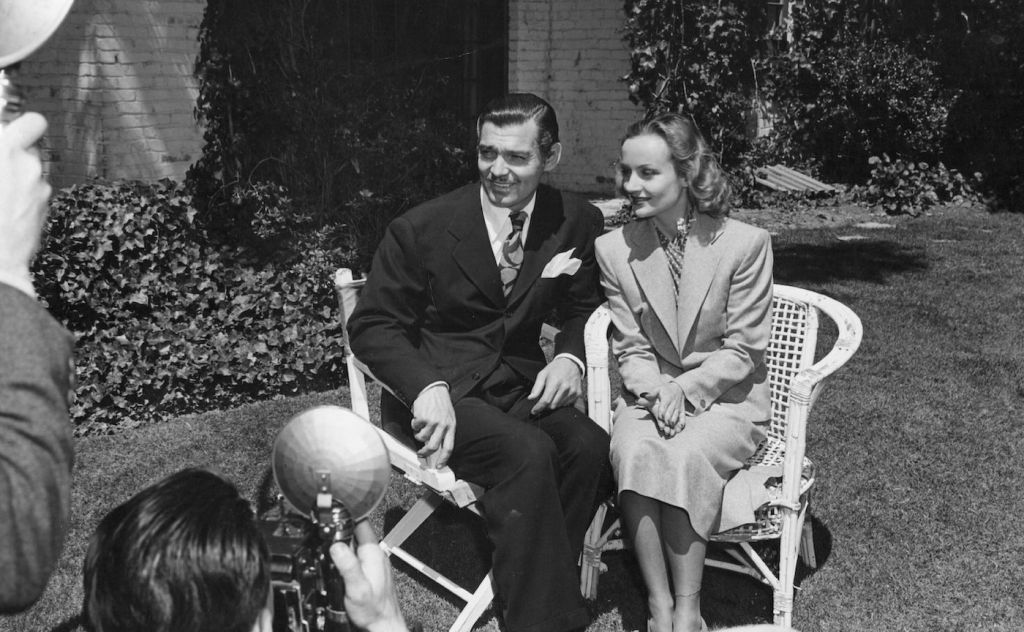
The King and Queen of Hollywood
Women were always easy for Clark Gable, and for a time so were wives. The first Mrs. Gable was Josephine Dillon, 17 years his senior, and she was introduced to him as an acting coach by another woman who was his then-fiancée. As a handsome, if unrefined son of an Ohioan farmer, the 23-year-old Gable was perfect clay for Dillon. She turned him into her greatest student, teaching him how to lower his voice and hold your attention. As his patron and wife, Dillon also introduced Gable to all her Broadway connections and the adjacent stock companies. It was even as the star of one of those companies that he met Maria Langham, a wealthy widow and oil heiress who was also 17 years his senior.
As the second Mrs. Gable, Ria introduced Gable to Manhattan’s high society and exquisite living, teaching him social etiquette and the value of a finely tailored tuxedo. One wife taught him how to play at being an actor, and the other taught him how to play at being a gentleman. They served their purposes and they were both brushed off.
But Lombard? He couldn’t brush her off ever.
The first time Clark met Carole, it was a surprisingly chaste affair. The two were cast as the leads of 1932’s No Man of Her Own. Unlike many of his leading ladies in the 1930s, Gable made no passes at Lombard, who was married to movie star William Powell at the time and intended to remain that way. Nevertheless, they hit it off, as the breathlessly quick-witted Lombard did with almost everyone.
Gable wasn’t yet “the King of Hollywood” then, but he was well on his way. Two years later, he’d star in the film that popularized screwball comedies, It Happened One Night (1934), which won him an Oscar for Best Actor, and two years after that he would lead the granddaddy of all disaster movies, San Francisco (1936). By ’38, he was already Tinseltown royalty when then-gossip columnist Ed Sullivan overheard Gable’s drinking buddy and sometime-rival, Spencer Tracy, affectionately refer to him as “King.” Sullivan immediately lit upon the idea of holding a national poll for the “King and Queen of Hollywood.”
More than 20 million people voted and, by a huge majority, Gable was crowned “King” for the rest of his career. Meanwhile, Myrna Loy was elected “Queen of Hollywood.” The fact they were then filming MGM’s Test Pilot (with Tracy) certainly suggests the results might’ve been tampered with. It also likely struck Loy as ironic since her first encounter with Gable ended with her pushing him into a hedge bush after he drunkenly bit the back of her neck while his second wife, Ria, was sitting in a nearby car. Gable refused for years to talk to Loy socially after that rejection, including between takes on film sets.
So yes, the King was a womanizer—complete with a secret baby born out of wedlock to co-star Loretta Young—in a sham marriage at the beginning of his reign. But things began changing when he finally ran into Lombard again, and at last he found his matching monarch.
It was at the White Ball in 1936 that the pair’s paths crossed a second time. By now, Clark was fully estranged from Ria, and the two lived in separate houses. Lombard, meanwhile, had risen to her own stardom by bringing her transgressive life-of-the-party persona to recent screwball comedies directed by Howard Hawks and Ernst Lubitsch. Vivacious, whip smart, and an eventual inspiration for Marion Ravenwood in Raiders of the Lost Ark, Lombard was a hard-drinking and giddy star with her own orbit.
According to Clark Gable: A Biography by Warren G. Harris, when Gable saw Lombard on the dance floor, he went up and said, “I go for you, Ma.” After a moment’s confusion, Lombard realized he was quoting their characters’ nicknames for each other in No Man of Her Own from four years earlier. She responded, “I go for you too, Pa.”
For the rest of their lives, they’d always refer to each other as “Ma” and “Pa.”
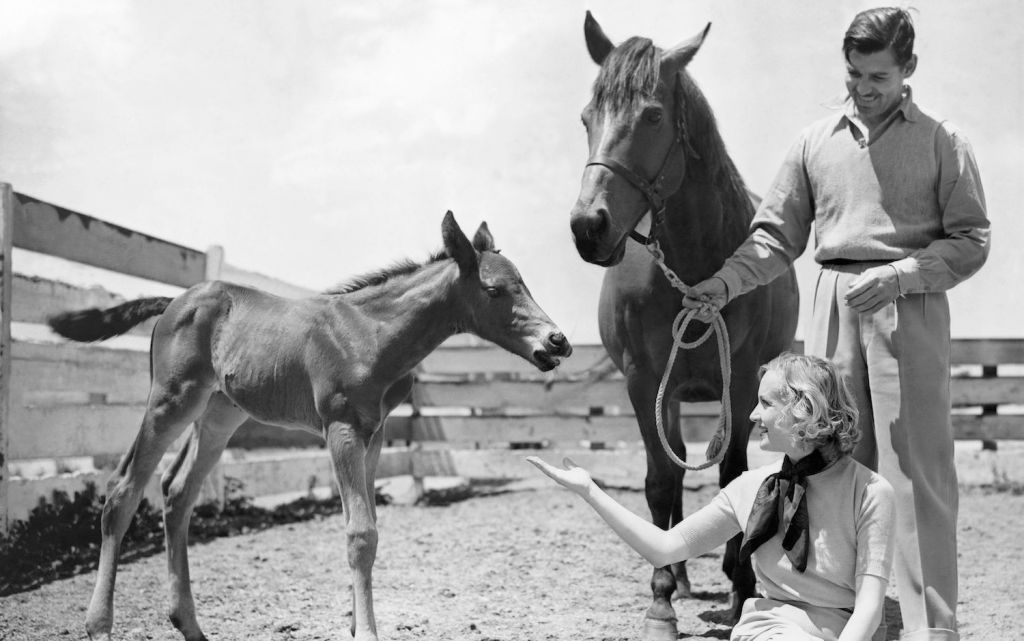
The Love of His Life
That first night on the dance floor actually ended in the pair’s first of many fights. But in a trick that would come to define the pattern of their relationship, Gable woke up the next morning in his hotel room with two doves sitting on his chest. They’d been secreted there with a note on one’s leg: “How about it? Carole.”
Unlike Gable’s other romantic entanglements, Lombard always controlled the tone and tempo of their courtship while Gable offered Lombard an escape from the glamour goddess, society girl image she’d molded herself to in Hollywood. She was an athlete growing up and, alongside Pa, she picked up outdoor-living again.
Clark taught Carole rifling, skeet-shooting, and camping. In ’38, she joined what had up to that point been Gable’s all-male hunting club with fellow actors and Hollywood talent. When the other men complained about a woman being present and sharing their bathroom, she brought along her own trailer with a private bathroom—taunting Clark and the others by then keeping him out. She crawled in the mud next to the dudes, and would soon be on all of the Gables’ hunting trips.
The pair eloped in ’39 after three years of courtship. This occurred in large part because Photoplay magazine revealed the two were living in sin (Gable was still married and too chintzy to get a divorce). Shortly after the embarrassment, however, Gable paid off his second wife and Lombard became the third Mrs. Gable.
“I just think of that husband of mine all the time,” Lombard once said with her usual candor. “I’m really stuck on the bastard. And it isn’t all that great lover crap, because if you want to know the truth, I’ve had better. No, I’m nuts about him and not just about his nuts.”
When the two moved into their Encino ranch, Gable made his gun collection the centerpiece when you walked in the front door, and Lombard began raising chickens and cattle. It was about as far from Beverly Hills as you could get, or as Lombard enthused, “The best little shit house in the San Fernando Valley.”
It was here that Lombard planned to soon retire, beginning with a one-year sabbatical in an effort to have children. Yet after a year of trying, they only had two miscarriages to show for it. They agreed to keep trying, but they’d soon run out of chances.

The Loss of His Life
When the bombs fell in Pearl Harbor, it was Carole who urged Clark to telegraph Roosevelt as soon as possible. She was also in the White House for the president’s fireside chat in 1940. And unlike Gable, she was furious when the president responded, “You are needed where you are.”
With the war finally here, Lombard urged Gable to join the Army in December 1941 while she hoped to join the Red Cross. For Christmas, instead of her usual lavish presents she sent all her friends engravings announcing she’d made a donation to the Red Cross in their name. And when she got wind of MGM publicity chief Howard Strickling trying to position Gable for a safe desk job in Washington D.C. for the course of the war, she told both men, “The last thing I want for Pappy is one of those phony commissions!”
Gable preferred helping the war where FDR told him he should—from the comfort of Hollywood. On Dec. 22, 1941, he presided over the first meeting of the Screen Actors Division of the Hollywood Victory Committee as its newly appointed chairman. The committee functioned as a way for Hollywood stars and leaders to organize all activities in support of the war effort. His wife was the first at the meeting to pledge her cooperation in donations, bond rallies, and touring the troops.
When a request came from the Treasury Department for the Victory Committee to launch Indiana’s participation in the national campaign of selling war bonds on Jan. 15, 1942, Gable recognized his Indiana-born wife as the perfect talent to send along. Carole was thrilled to go, although apprehensive about leaving Clark behind.
Gable couldn’t join his wife on her journey by train because he was about to start work on Somewhere I’ll Find You: his second film with Lana Turner. Up until then, Carole had been very open-minded about Gable’s continued infidelities and little affairs, even after they were married. She turned a blind eye to more than one rumor of him sleeping with a co-star here, or a starstruck journalist there, because she assumed you had to let Clark Gable be Clark Gable. But she drew the line over rumors about Clark and Lana, the latter of whom was infamously dubbed the “Sweater Girl” when she was discovered at a soda fountain at age 16. Blonde and buxom, Turner was 20-years-old when she first worked with the 40-year-old Gable. These stories did get to Lombard.
The evening before she left for Indiana, the couple had a huge blowout during which Clark failed to convince his wife he never slept with Lana Turner. The last night Gable and Lombard were under the same roof, they slept in different beds. The next morning, he did not see his wife off to the train station.
As with many of their fights, things cooled almost immediately. Before she left, Lombard still delivered a pack of handwritten love letters to her live-in secretary Jean Garceau to deliver to Clark, one at a time, everyday she was away. She also had the prank she planned before their fight still be delivered, so when Gable returned home from work that night he found a naked blonde dummy in his bed with a note. “So you won’t be lonely.” Gable reportedly laughed until he had tears in his eyes.
According to Garceau when the two talked by phone the next night, they sounded like “lovebirds” again. And according to the You Must Remember This podcast, Gable had Carole’s hotel room in Indianapolis be covered in red roses when she got in. But before even then, Lombard’s train stopped in Salt Lake City where she saw the troops marching and immediately telegraphed her husband, “HEY PAPPY, YOU’D BETTER GET INTO THIS MAN’S ARMY.”
On Jan. 15, Lombard intended to raise $500,000 in war bonds. Instead, she raised over $2 million. Afterward, she was so eager to get home to Gable following their fight that she decided she’d fly back to California instead of returning by train. This was expressly forbidden by the Treasury Department. Commercial travel was still relatively dicey, and they feared she’d be a target for Nazi saboteurs. Additionally, she was traveling with her mother Elizabeth Peters, a superstitious woman who’d never flown and was deathly afraid to start now. She was also there with Otto Winkler, Gable’s publicist and buddy who was best man at their wedding.
The morning their flight was to leave Indianapolis, Otto got Carole to at least agree to a coin toss. Heads they fly, tails they take the train. Carole won. From Indianapolis, they would make multiple stops, including Wichita, Albuquerque, and Las Vegas. TWA Flight Number 3 never reached Burbank.
That night Gable arranged a surprise party to welcome the three heroes back—as well as a surprise male dummy with an erection waiting for Carole upstairs. He was reportedly giddy waiting for the phone call from limo driver Larry Barbier, who was supposed to report when they landed. Instead, Clark got a call from MGM fixer Eddie Mannix.
“Can I get back to you?” Gable asked. “I’m expecting word on Ma’s arrival any minute.”
Mannix cut him off. “King, that’s why I’m calling. Larry Barbier just phoned from the airport. Carole’s plane went down just a few minutes after it left Las Vegas.” She was gone.
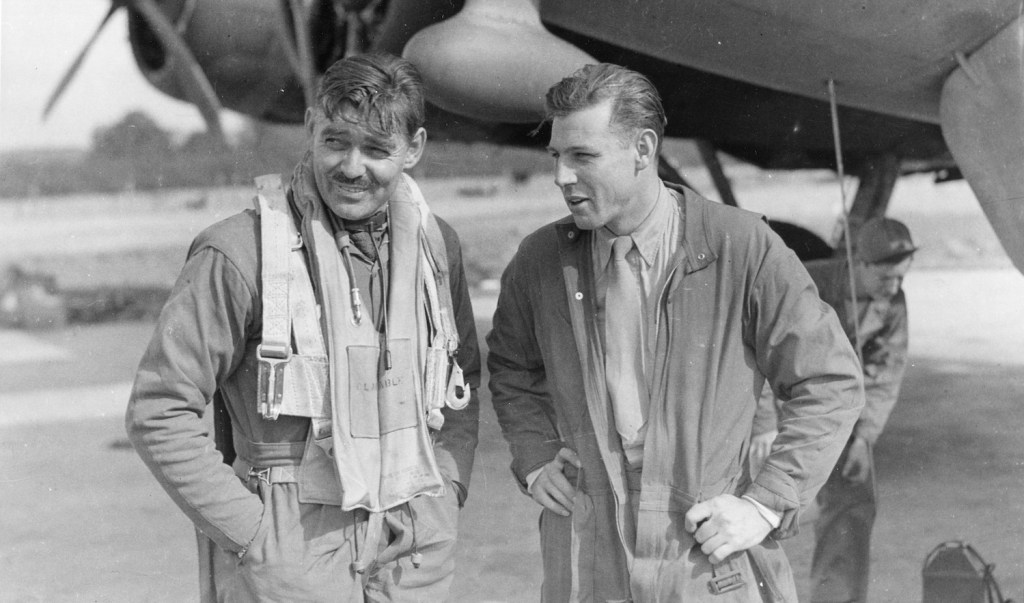
Clark Gable Goes to War
The fallout from the literal wreckage of Lombard’s flight was national news. A bewildered Gable joined Mannix and other MGM brass for their own chartered flight to Vegas. He could see the burning debris that Lombard’s flight smeared across Table Rock Mountain from the air. Locals in the city described it as “apocalyptic” and like an “inferno.”
Mannix refused to let Gable go on the rescue party climbing the mountain—convincing him Carole, Otto, and Bettie might have survived and were now walking to the city. So the star stayed behind and drank. The next morning, he received a cable from Mannix. “NO SURVIVORS. ALL KILLED INSTANTLY.”
In truth, the bodies of Lombard and everyone else on board had been more or less cremated by the fire after impact. And while Mannix couldn’t be certain, he believed he found what was left of Carole: a decapitated, charred body with a few blonde strands of hair and the remnants of a ruby and diamond pin Gable had given his wife the year before. He never told Clark about what he saw, but brought back the hairs and piece of ruby.
The next day, FDR sent Gable private condolences and publicly awarded Lombard a medal as “the first woman to be killed in action in the defense of her country in its war against the Axis powers.”
The official and (likely) reason for that flight’s crash is it was overloaded with servicemen and movie star luggage, and the pilot failed to see the mountain in front of him, on which all lights had been turned off to preserve wartime power. Although, according to Orson Welles (as per You Must Remember This), Hollywood and government insiders all knew Nazi saboteurs did in fact bring down the plane, and Roosevelt covered it up to prevent a nationwide panic.
In the months that followed, Gable grew quiet and despondent, losing 20 pounds despite drinking untold amounts of Scotch every day. He dined alone for all meals and began wearing a locket with Carole’s hair and ruby remnants within. According to household staff, he rarely slept and stayed up all hours of the night watching 16mm prints of Lombard’s old movies he had sent over (she’d given him the projector as a Christmas present). Now he had time for no woman except the one he lost.
When he discovered MGM was still trying to keep him from being drafted—with the age range now being raised to 45—Gable grew furious. A scriptwriter pal put him in touch with Col. Luke Smith of the Army Air Corps, who told Gable he should consider applying for training as an aerial gunner since it’s one of those jobs no one seems interested in.
“Everybody wants to be a pilot,” Smith told Gable. “Your becoming a gunner would help to glorify the plane crews and the grease monkeys.” Gable made up his mind to enlist in spite of the wrath of MGM head Louis B. Mayer. He also defied the constraints of his age of 41 by passing the physical—save for the need of getting triplicates of his new dentures (Gable had false teeth his whole career).
On Aug. 12, 1942, Gable enlisted into the Army air force. Right beforehand he told Jill Winkler, Otto’s widow, “I’m going in, and I don’t expect to come back, and I don’t really give a hoot whether I do or not.”
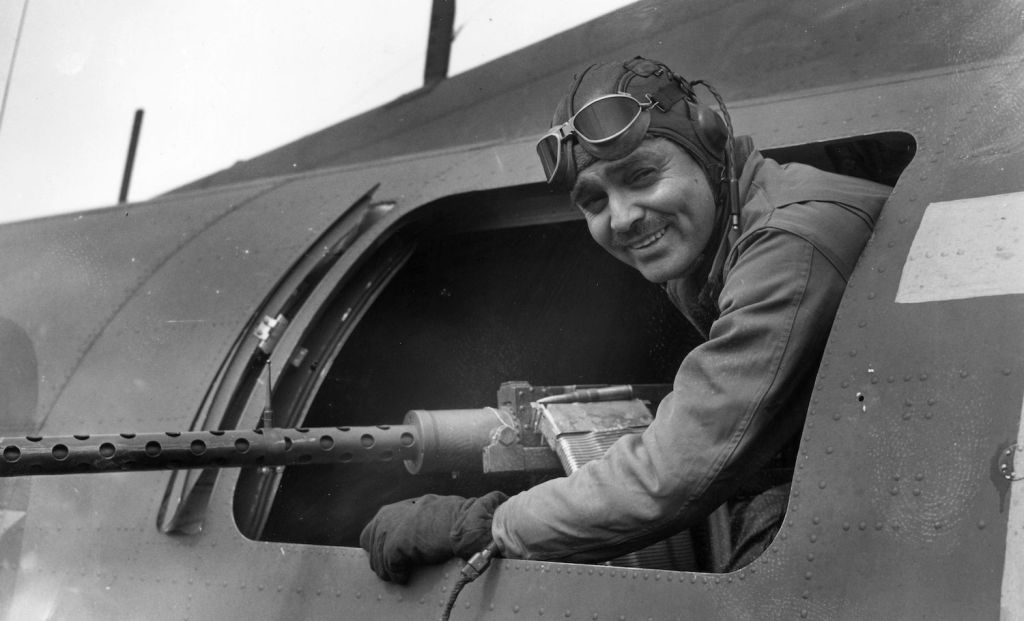
The Aerial Gunner with a Death Wish
There is still much speculation over whether Gable actually wanted to die in World War II. His superiors eventually reached that conclusion based on his cavalier attitude, and he at least seemed ambivalent about the whole affair. However, it is interesting he joined the air force considering that, after Lombard’s death, he developed a fear of flying for the rest of his life. Following the war, he would always prefer to make his transatlantic crossings by ocean liners instead of planes.
But during the war? Frankly, he didn’t seem to give a damn one way or the other.
Gable’s biggest fear during the whole conflict was his struggle to pass officer’s training in a 90-day course stateside. A high school dropout, Gable was challenged by the academic course work, which he ultimately got around by treating each textbook like a script he needed to memorize.
Once he was an officer (and allowed to grow back his trademark mustache), he seemed in relatively good spirits for the first time in months. Before going overseas, he told Garceau, “I have everything in the world anyone could want, but for one thing. All I really need and want is Ma.”
In April 1943, Gable was shipped off to join the 351st Heavy Bombardment Group in Peterborough, England, about 80 miles north of London. Gable also received an automatic promotion to the rank of captain, although this had as much to do with the heavy losses of Allied officers as it did with Gable’s leadership.
In truth, Gable likely enjoyed playing the part of officer more than he entirely became it. The military loved letting him pose for the press as a gunner with a bombardier’s bullets wrapped around his neck, but that wasn’t his actual job. While Gable did on at least two occasions take on the role of aerial gunner in combat, his official role was as an observational gunner—he was there to pick up the weapons in the side or rear of a B-17 if the gunner operating it was injured or killed (which did happen).
Otherwise, Gable was there because the Army wanted him to film footage they could use as propaganda, glorifying the role of gunners. While in officer’s school, the Army reunited Gable with cinematographer Andy McIntyre, who would become his sidekick and cameraman in the air. And after his graduation, Gable arranged the transfer of his scriptwriting buddy John Lee Mahin, then a lieutenant serving as an instructor in Combat Intelligence, to join them. In all, Gable and McIntyre built a film crew of six men to film the other fliers on B-17 missions. They were called “the Little Hollywood Group.”
More than twice the age of many of the pilots and gunners he flew with, Gable found himself facing heavy skepticism in his early training.
“None of the kids believed he was going to do anything at all,” Mahin recalled in Warren’s Clark Gable biography. “They never thought he was going to expose himself to any kind of danger. They said it was all a lot of bullshit. It really killed Clark that the kids shunned him.”
The brass, however, loved Gable at first. Many of his superiors invited him nearly every night to dinner, an annoyance he’d soon relegate to one evening a week. And while he welcomed the press to photograph him at the planes, he also refused the special treatment of having private quarters set up, which earned him more respect from the young fliers.
He’d also soon prove himself as a member of Col. William Hatcher’s Chickens (a nickname for his bombing group) when he went up in the air on May 4, 1943. Hatcher was onboard the same B-17 that day as group commander and co-pilot; the 351st were tasked with taking out several factories in Nazi-occupied Antwerp, Belgium.
During Gable’s first combat mission, flak from ground defenses took out one of the plane’s four engines and its stabilizer. More unnervingly, after delivering the plane’s payload, a German’s 20mm shell pierced the center of the plane, with the corner of the shell passing through the heel of Gable’s boot—lifting it clean off—and then exiting the aircraft inches above Gable’s head.
On another mission, Gable took over for gunners who were wounded or killed (there was at least one of each that day). Fifteen holes were found in the fuselage. For Gable, such horrors were also a vindication, as he fully won the respect of the kids around him.
“They adored him,” Mahin recalled. “They couldn’t stay away from him. And he was proud that they accepted him.”
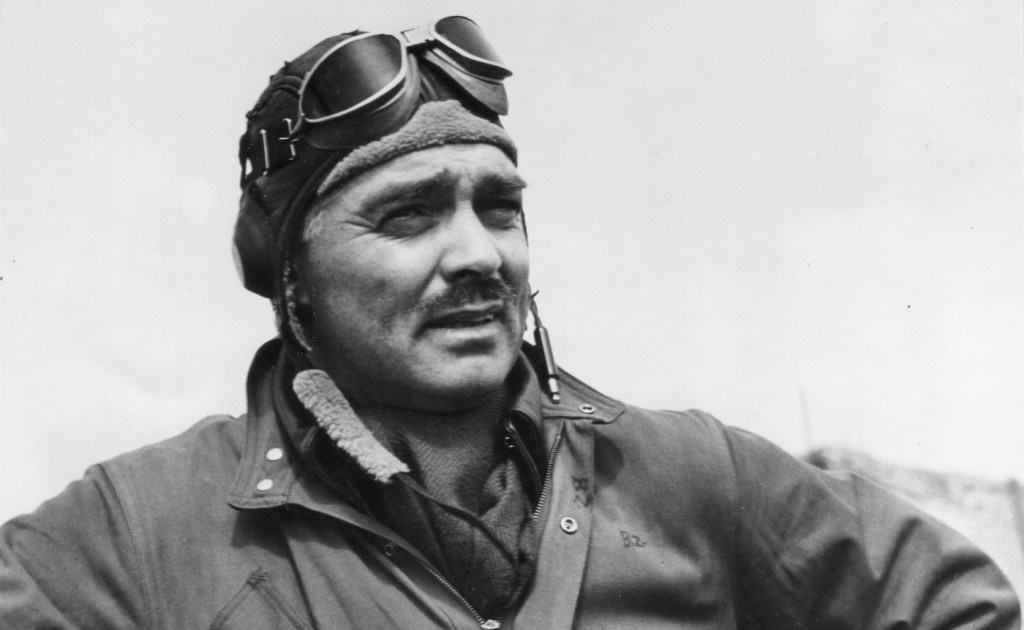
Hitler’s Prize
At Peterborough, Gable grew increasingly chummy with the other fliers serving. He bought a used motorcycle and would make small talk on trips around the base. And on more than a few weekends, he would head to London to screen at MGM offices some of the footage he shot in the air. He also would meet with his pre-war Hollywood chum, David Niven, who was serving as an instructor for British Commandos and had recently married and had a son.
“From then on our cottage became Clark’s refuge from military life,” Niven recalled. “With Carole’s death, he had been dealt the cruelest of blows, but on the surface at least, he was making the best of it. In his own deep misery, he found it possible to rejoice over the great happiness that had come my way, and he became devoted to my little family.”
Niven added, “Clark’s personal wounds seemed to be healing, but Carole was never far from him, and the very happiness of our little group would sometimes overwhelm him. [My wife] found him one evening on an upturned wheelbarrow in the garden, his head in his hands, weeping uncontrollably.”
Still, Gable seemed to be settling into a new happy rhythm of camaraderie on the base, frequent trips to London, and even playing the field. He renewed an affair with a pre-Lombard paramour in London, the English (and now married with children) Elizabeth Allan. Nonetheless, he may have been enjoying himself too much for his superiors’ liking.
Robert Matzen, author of Mission: Jimmy Stewart and the Fight for Europe and Fireball: Carole Lombard and the Mystery of Flight 3, told me he believed Gable had a death wish.
“Carole Lombard, his wife, wanted him to go fight and she’s killed,” Matzen said. “So he then decides, ‘Alright, I’ll go fight and hopefully I’ll be killed too.’ That’s why he wanted to be in the Eighth Air Force, because he wanted to die in a plane crash.” Also, unlike Stewart, Matzen stressed, Gable never fully adapted to military culture.
Said Matzen, “Gable was much more interested in being Clark Gable in England than Jim Stewart was interested in being Jimmy Stewart in England.” This weighed on the mind of Col. Hatcher, as did the growing understanding that every B-17 Gable was on became a prize for Nazi Germany.
The day the 351st arrived in England, Nazi radio propagandist William Joyce, aka “Lord Haw Haw,” broadcast from Berlin the following: “Welcome to England, Hatcher’s Chickens. Among whom is famous American cinema star, Clark Gable. We’ll be seeing you soon in Germany, Clark. You will be welcome there too.”
Adolf Hitler apparently adored Clark Gable, considering him his favorite American actor. A movie nut with a love for British and Hollywood cinema, Hitler even allegedly smuggled a film print of Gone with the Wind before it opened in the UK. Hitler therefore marked Gable as one of the most prized “war criminals” in the Allied Forces, offering a handsome reward to any German soldiers who can bring Gable to him alive.
The actor was terrified of being paraded through Berlin like King Kong and was only half-joking when he told a friend, “If Hitler catches me, the sonofabitch will put me in a cage like a gorilla and send me on a tour of Germany. If a plane that I’m in ever gets hit, I’m not bailing out.”
While his superiors might’ve appreciated the sentiment, they feared the humiliating spectacle of one of their gunners becoming a Nazi political tool—or the actor putting a bigger target on their bombing group. Additionally, Gable didn’t follow protocol as intended, at one point threatening a military doctor after the physician apparently said nonchalantly that Gable’s pal had hours to live while the young man was awake and listening. And, again, the opinion became that he wanted to be shot down.
So it was in October 1943, after only five combat missions, Capt. Gable was awarded the Distinguished Flying Cross and the Air Medal for “exceptionally meritorious achievement while participating in five separate bomber combat missions.” Hatcher apparently pulled the strings to get Gable out.
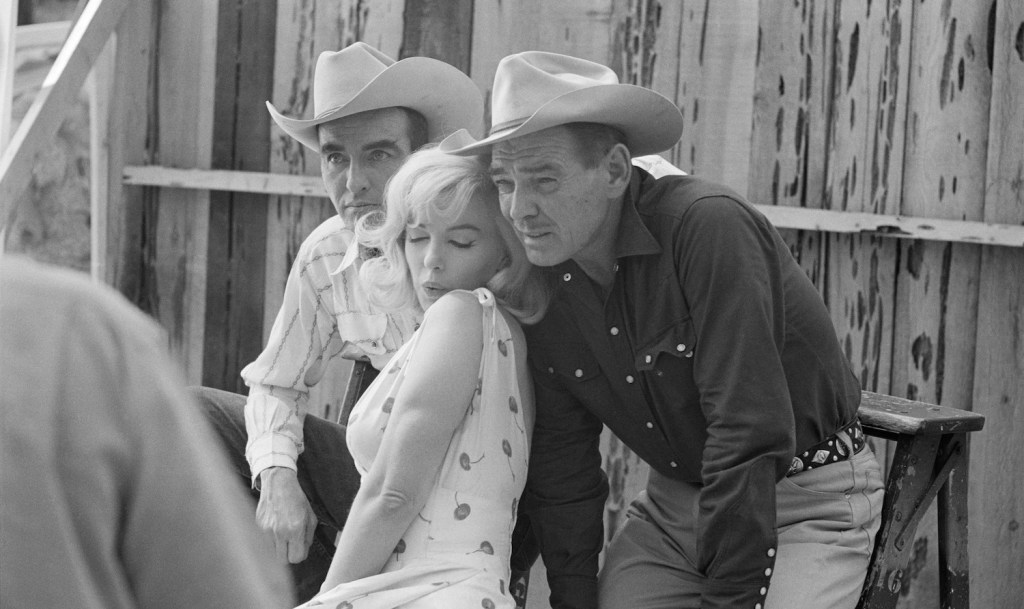
The End
Even though Gable’s time in combat ended in October of ’43, he still wound up with 50,000 feet of film at his disposal. He was apparently shocked when he learned the air force really didn’t care what he did with the footage since gunner recruitment was up. So he returned to Los Angeles, having been reassigned to the city’s photographic division. Allowed to cut the film at MGM, Gable put together five short films that could be used for instruction on operating B-17s. But by the time it made its way through the Pentagon’s chain of command… the war was over. The footage mostly still lies unused in government archives.
After finishing the films, Gable had expected to be assigned to a new bombing division in the Pacific Theater. As he waited months for the orders to come in, he found out on the news about the D-Day landing in Europe on June 6, 1944. Feeling forgotten and discarded by the Air Corps, he requested to be discharged on June 12, which was his right as a volunteer over the age of 42. A captain named Ronald Reagan granted Gable his discharge after 670 days of service.
Clark eventually re-acclimated to Hollywood and restarted his career, but by 1945 his days as “the King” were waning, and he saw more flops accompany his diminishing hits. He also had many more affairs with leading ladies, extras, and socialites. But for years he refused to marry, telling friends, “It wouldn’t be fair. I have nothing left to give.”
For the rest of his life, Clark mourned Carole, including on Jan. 15, 1944 when he was on hand for the launch of the SS Carole Lombard. Gable was supposed to speak at the event. Instead, he mostly cried.
Eventually he did remarry, twice, and finally had one child who wasn’t disowned in secret. But after the star died of a heart attack at age 59 in 1960, his fifth wife, Kay Williams, honored his final wishes: Gable was interred at Glendale’s Forest Lawn Memorial Park. Next to Ma.

